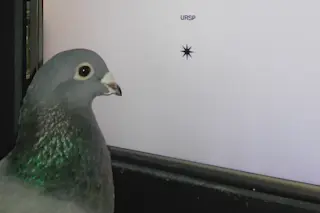A pigeon scrutinizes a word (gibberish) during training. (Credit: William van der Vliet) Birds are rapidly building their reputation as a brainy bunch, and the latest credit goes to four pigeons who can visually recognize written words. These pigeons were living in a lab in New Zealand where, over a span of two years, they learned to distinguish four-letter English words from nonsense words. For their training, a computer screen would flash words like “DOWN” or “GAME”, and non-words like “TWOR” or “NELD”, along with a star symbol. Each time the pigeons made a correct identification — pecking the word if it was a real one, or pecking the star symbol beneath a non-word — they were rewarded with a portion of wheat.
After the pigeons built up decent vocabularies (the star pupil acquired 58 words), the screen began flashing new words that they had never seen before. And even ...














